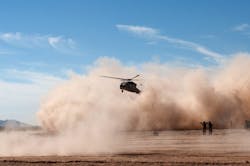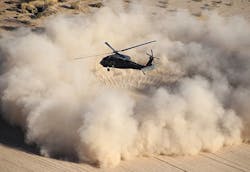Lockheed Martin sensor fusion testbed to boost situational awareness, enhance helicopter survivability
Photo Credit: Mr. Mark Schauer (ATEC)
ORLANDO, Fla. Lockheed Martin (NYSE:LMT) engineers in Orlando, Florida, are designing and developing a Multi-Modal Sensor Fusion (MMSF) testbed for rotary-wing aircraft that blends data from multiple sensors to restore the pilot’s situational awareness in degraded visual environments (DVEs) under a $12 million U.S. Army contract.
Under the Army’s Night Vision and Electronic Sensors Directorate (NVESD), Lockheed Martin is developing sensor fusion and integration technologies that enhance rotary-wing aircraft survivability and enable pilots to navigate safely in all environments, including when GPS is unavailable. The MMSF algorithms blend data from multiple sensor types to restore a pilot's situational awareness in degraded visual environments.
Photo Credit: Mr. Mark Schauer (ATEC)
“Current Lockheed Martin fire control systems enable pilots to own the night,” says Paul Lemmo, vice president of Fire Control/SOF CLSS at Lockheed Martin Missiles and Fire Control. “Our next-generation MMSF technology will help them own the environment as well. Our work with NVESD and other DVE stakeholders will enable helicopter aircrews to operate more safely and effectively in even the most challenging visual environments.”
During the 40-month effort, Lockheed Martin engineers will integrate government-furnished sensors in a reconfigurable, open-architecture testbed that supports the development of DVE systems for rotary-wing aircraft. Other activities include refining multi-modal fusion techniques and real-time 3D mapping, and implementing symbols and cues for pilot sensor displays.
MMSF blends sensor data to generate real-time 3D terrain maps of the area around the aircraft that can identify and highlight obstacles to improve situational awareness for pilots, mission commanders, and other platforms. Potential recipients of such capabilities include existing Army helicopters and Future Vertical Lift solutions.
Headquartered in Bethesda, Maryland, Lockheed Martin is a global security and aerospace company that employs approximately 97,000 people worldwide and is principally engaged in the research, design, development, manufacture, integration and sustainment of advanced technology systems, products and services.
”>Avionics & Electronics in the Cockpit
Across all market segments
Subscribe to the free Intelligent Inbox e-newsletter
Subscribe to receive all the latest aerospace technology news & information, delivered directly to your e-mail inbox twice a week (Tuesdays and Thursdays). Sign upfor your free subscription to the Intelligent Inbox e-newsletter at http://www.intelligent-aerospace.com/subscribe.html.
Connect on social media
Keep pace with aerospace innovation and opportunities via your favorite social media channels. Connect with Intelligent Aerospace on Twitter (@IntelligentAero), LinkedIn,Google+, and Instagram.


